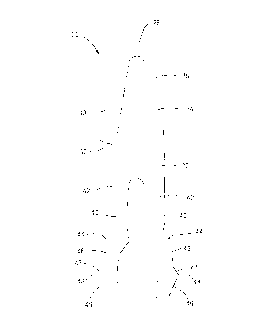Une partie des informations de ce site Web a été fournie par des sources externes. Le gouvernement du Canada n'assume aucune responsabilité concernant la précision, l'actualité ou la fiabilité des informations fournies par les sources externes. Les utilisateurs qui désirent employer cette information devraient consulter directement la source des informations. Le contenu fourni par les sources externes n'est pas assujetti aux exigences sur les langues officielles, la protection des renseignements personnels et l'accessibilité.
L'apparition de différences dans le texte et l'image des Revendications et de l'Abrégé dépend du moment auquel le document est publié. Les textes des Revendications et de l'Abrégé sont affichés :
| (12) Demande de brevet: | (11) CA 2227714 |
|---|---|
| (54) Titre français: | DISPOSITIF SERVANT A MONTER UNE COMPOSANTE |
| (54) Titre anglais: | COMPONENT MOUNTING DEVICE |
| Statut: | Réputée abandonnée et au-delà du délai pour le rétablissement - en attente de la réponse à l’avis de communication rejetée |
| (51) Classification internationale des brevets (CIB): |
|
|---|---|
| (72) Inventeurs : |
|
| (73) Titulaires : |
|
| (71) Demandeurs : |
|
| (74) Agent: | SMART & BIGGAR LP |
| (74) Co-agent: | |
| (45) Délivré: | |
| (22) Date de dépôt: | 1998-01-21 |
| (41) Mise à la disponibilité du public: | 1998-08-20 |
| Licence disponible: | S.O. |
| Cédé au domaine public: | S.O. |
| (25) Langue des documents déposés: | Anglais |
| Traité de coopération en matière de brevets (PCT): | Non |
|---|
| (30) Données de priorité de la demande: | ||||||
|---|---|---|---|---|---|---|
|
L'invention comporte un dispositif de support constitué d'un corps doté d'une partie centrale et de deux pattes élastiques partant de la partie centrale dans une première direction. Les pattes comportent des éléments engageant une carte de circuits imprimés. Le corps est muni d'un bras à crochet qui va dans une deuxième direction à partir de la partie centrale pour s'engager dans une composante. Le bras crochet comporte une première partie qui va dans la deuxième direction et une partie déviée par flexion vers la partie centrale. La partie déviée par flexion peut être déviée vers la première partie pour permettre le passage par un trou de fixation et elle comporte une extrémité engageant la composante pour la fixer au corps. Ce dermier maintient la composante sur la carte de circuits imprimés.
The invention comprises a holding device having a
body member with a central portion and two resilient
legs extending therefrom in a first direction. The legs
have engagement members for engaging a circuit board.
The body member has a hook arm extending in a second
direction from the central portion for engagemtne with a
component. The hook arm has a first portion extending
in the second direction and a resiliently deflectable
portion extending towards the central portion. The
resiliently deflectable portion being deflectable
towards the first portion to allow passage through a
mounting hole and has an end for engaging the component
to secure the body member thereto. The body member
secures the component to the circuit board.
Note : Les revendications sont présentées dans la langue officielle dans laquelle elles ont été soumises.
Note : Les descriptions sont présentées dans la langue officielle dans laquelle elles ont été soumises.

2024-08-01 : Dans le cadre de la transition vers les Brevets de nouvelle génération (BNG), la base de données sur les brevets canadiens (BDBC) contient désormais un Historique d'événement plus détaillé, qui reproduit le Journal des événements de notre nouvelle solution interne.
Veuillez noter que les événements débutant par « Inactive : » se réfèrent à des événements qui ne sont plus utilisés dans notre nouvelle solution interne.
Pour une meilleure compréhension de l'état de la demande ou brevet qui figure sur cette page, la rubrique Mise en garde , et les descriptions de Brevet , Historique d'événement , Taxes périodiques et Historique des paiements devraient être consultées.
| Description | Date |
|---|---|
| Inactive : CIB de MCD | 2006-03-12 |
| Le délai pour l'annulation est expiré | 2003-01-21 |
| Demande non rétablie avant l'échéance | 2003-01-21 |
| Réputée abandonnée - omission de répondre à un avis sur les taxes pour le maintien en état | 2002-01-21 |
| Demande publiée (accessible au public) | 1998-08-20 |
| Symbole de classement modifié | 1998-05-04 |
| Inactive : CIB attribuée | 1998-05-04 |
| Inactive : CIB en 1re position | 1998-05-04 |
| Exigences de dépôt - jugé conforme | 1998-04-20 |
| Inactive : Certificat de dépôt - Sans RE (Anglais) | 1998-04-20 |
| Demande reçue - nationale ordinaire | 1998-04-16 |
| Date d'abandonnement | Raison | Date de rétablissement |
|---|---|---|
| 2002-01-21 |
Le dernier paiement a été reçu le 2000-12-21
Avis : Si le paiement en totalité n'a pas été reçu au plus tard à la date indiquée, une taxe supplémentaire peut être imposée, soit une des taxes suivantes :
Veuillez vous référer à la page web des taxes sur les brevets de l'OPIC pour voir tous les montants actuels des taxes.
| Type de taxes | Anniversaire | Échéance | Date payée |
|---|---|---|---|
| Taxe pour le dépôt - générale | 1998-01-21 | ||
| Enregistrement d'un document | 1998-02-19 | ||
| TM (demande, 2e anniv.) - générale | 02 | 2000-01-21 | 1999-12-15 |
| TM (demande, 3e anniv.) - générale | 03 | 2001-01-22 | 2000-12-21 |
Les titulaires actuels et antérieures au dossier sont affichés en ordre alphabétique.
| Titulaires actuels au dossier |
|---|
| THE WHITAKER CORPORATION |
| Titulaires antérieures au dossier |
|---|
| KENT A. WESTLUND |